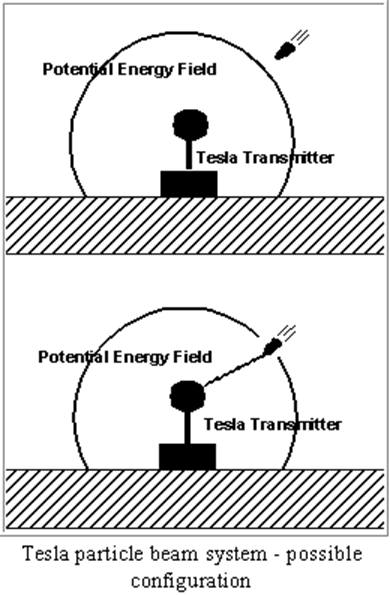

Antentop is FREE e-magazine devoted to Antennas and Amateur Radio an
Special page devoted to
Tesla Wireless and the Tunguska Explosion

Custom Search
|
ANTENTOP-
02- 2003, # 003 |
Tesla Wireless and the Tunguska Explosion |
|
|
|
||
|
Not wanting to give away a potentially
valuable creation in an interview, he was intentionally opaque
concerning the details of his design. He did clarify how his design
differed from the ray type of devices. My apparatus
projects particles which may be relatively large or of microscopic
dimensions, enabling us to convey to a small area at a great distance
trillions of times more energy than is possible with rays of any
kind. Many thousands of horsepower can be thus transmitted by
a stream thinner than a hair, so that nothing can resist.
|
If Tesla's energy weapon cannot be called a "ray" device, but
as one projecting microscopic particles, it would seem that it
had to differ from the other designs in one of two ways. Either
he was making the distinction between a beam of radiant energy,
like a beam from a flashlight that has billions of energy carrying
photons, and his own with all of its energy concentrated into
a stream a single particle wide, or he was making a distinction
about the size of the beam and the method it is used to reach
the target. In a Grindell-Matthews type of beam, the flashlight model, a huge number
of high energy particles or photons would have to be sent out
from the system so that a large enough area on the target would
be covered to disable it. What Tesla seems to have intended was
that his energy transmitter would set up a field of force around
itself which, when penetrated, would release its energy directly
to the target. The effect would be like sending a current of particles
through a wire directly to the target. A large area on the target
would not have to be "painted" by a beam, so the current
reaching the intruder could be very thin and deliver a great deal
of energy to a small area. The Colorado tests
that gave rise to the variety of "death ray" inventions
in the U.S. and Europe may have lead to the development of a much
more powerful weapon. When Tesla realized that economic forces would not allow the development
of a new type of electrical generator that would supply power
without burning fuel he "was led to recognize [that] the
transmission of electrical energy to any distance through the
media as by far the best solution of the great problem of harnessing
the sun's energy for the use of man."(15),(16)
His idea was that a relatively few generating plants
located near waterfalls would supply his very high energy transmitters
which, in turn, would send power through the earth to be picked
up wherever it was needed. Receiving energy from this high pressure reservoir only would require
a person to put a rod into the ground and connect it to a receiver
operating in resonance with the electrical motion in the earth.
As Tesla described in 1911, "The entire apparatus for lighting
the average country dwelling will contain no moving parts whatever,
and could be readily carried about in a small valise."(17) The difference between a current used to "light
the average country dwelling" and a current used as a method
of destruction, however, is a matter of timing. If the amount
of electricity used to run a television for an hour is released
in a millionth of a second, it would have a very different, and
negative, effect on the television. |
|
|
|
|
|
|
Page 81 |
||
 |
 |
 |
 |
Just for Fun:

Powered byIP2Location.com
Thanks for your time!
Last Updated:
February 8, 2018 22:27





